These notes are intended to provide a casual sky watcher or someone already into amateur astronomy living in Eastern Australia with a summary of what is happening in the night sky in August 2013. The finder charts have been produced for an observer based on the Gold Coast (Queensland, Australia) but will be useful for observers elsewhere in Eastern Australia.
Instructions on how to obtain customised satellite viewing information for your location can be found here. If you find this page of interest, you may wish to follow this website automatically using Twitter and the sites RSS Feed.
Planets for August 2013
Venus is visible low above the Western horizon as evening twilight ends. Saturn is visible above the Western horizon at the end of evening twilight. Mars and Jupiter are visible low above the North Eastern horizon as morning twilight begins. Neptune rises around 6:15 pm mid-month and Uranus rises just after 9 pm mid-month. Mercury is briefly visible at the start of August in the bright dawn twilight before moving back towards the glare of the Sun.
Note that to the unaided eye that all planets look like stars. The word planet is A planet (from Ancient Greek ἀστὴρ πλανήτης (astēr planētēs), means “wandering star”).
Meteor Showers for August 2013
The Perseid meteor shower is the only major meteor shower which occurs during August 2013. Unfortunately the shower is best observed from mid-Northern latitudes and is not visible from the Southern Hemisphere. More information about the Perseid Meteor Shower can be found on the International Meteor Organisation website at http://imo.net/calendar/2013.
Individual Sky Events for August 2013
All times AEST unless otherwise stated.
All month: Early evening sky. If you are lucky enough to live away from bright street lights, don’t forget to look for the ancient Aboriginal constellation The Emu. Unlike traditional European constellations, Aboriginal constellations can use the dark patches (in reality giant dust clouds drifting in space that obscure light from background stars) in the Milky Way to represent creatures from the Dreamtime. Background information about the Emu can be found at http://www.abc.net.au/science/articles/2009/07/27/2632463.htm#.UaIGsfFqM7y. The head of the Emu is made up of what astronomers refer to as the Coal Sack nebula located in the constellation Crux (more commonly known as the Southern Cross) and the body stretches across the ancient Greek constellation Scorpius and the legs past it. It is an enormous constellation and once you have seen it from a dark sky site, you will wonder why you had never noticed it before. A finder chart can be found at http://astroblogger.blogspot.com.au/2009/07/seeing-emu.html. Note that the real constellation is much more like an emu than that shown in the finder chart.
2 August 2013: Crescent Moon located below Aldebaran (the brightest star in the ancient Greek constellation Taurus The Bull). Morning pre-dawn sky.
3 August 2013: 7 pm Moon at apogee (405,832 km from Earth in its orbit)
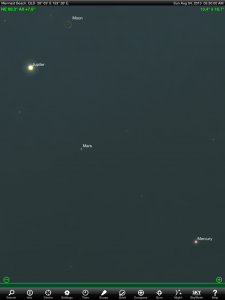
4 August 2013: Crescent Moon located above and to right of Jupiter. Morning twilight sky.
4 August 2013: 11 am Minor planet Juno at opposition
5 August 2013: Crescent Moon located to right of Mars and above Mercury. Morning twilight sky.
6 August 2013: 2 pm Minor planet Vesta in conjunction with the Sun
7 August 2013: 7:51 am New Moon
7 August 2013: Mercury at ascending node
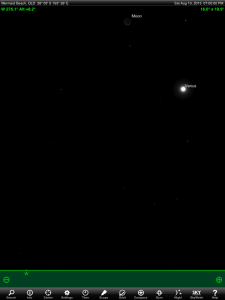
12 August 2013: Mercury at perihelion
12 August 2013: Crescent Moon located below Spica (the brightest star in the ancient Greek constellation Virgo The Virgin). Early evening sky.
13 August 2013: Mercury 0.3 degrees South of M44 Beehive Cluster
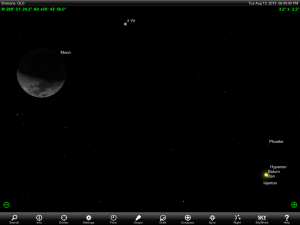
13 August 2013: Waxing crescent Moon located to left of Saturn. Early evening sky.
14 August 2013: Venus and Beta Virginis close
14 August 2013: 8:56 pm First Quarter Moon
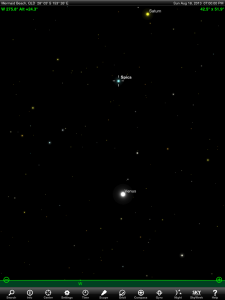
18 August 2013: 7 pm Venus, Saturn and the star Spica (the brightest star in the ancient Greek constellation Virgo The Virgin) continue to be visible to the unaided eye above the Western horizon.
18 August 2013: 11 am Minor planet Ceres in conjunction with the Sun
19 August 2013: 11 am Moon at perigee (362,264 km from Earth in its orbit)
21 August 2013: 11:45 am Full Moon
21 August 2013: 10 pm Minor planet 387 Aquitania 0.1 degrees East of NGC 6716
22 August 2013: Mercury at greatest latitude North
25 August 2013: 7 am Mercury in superior conjunction
27 August 2013: Noon Neptune at opposition (closest to the Earth in its orbit for 2013)
28 August 2013: 7:35 pm Last Quarter Moon
30 August 2013: Venus at descending node
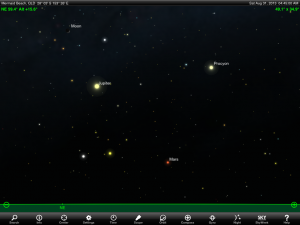
31 August 2013: 10 am Moon at apogee (404,881 km from Earth in its orbit)
For Further Information
Customised Astronomy & Satellite Viewing information
Information on how to obtain customised astronomy & satellite viewing information for your location can be found here on this website.
Information About The Finder Charts
Charts accompanying this article have been produced with permission using the highly recommended Sky Safari Pro tablet app. Stars are shown to 5th magnitude. This is a compromise between what would be seen from a dark sky site and the reality that most people live in cities or towns with significant light pollution.
References
The information in this post has been prepared using the following references.
- Astronomy 2013, Quasar Publishing http://www.quasarastronomy.
com.au/ - Sky Safari Pro Ipad app, http://www.southernstars.com/
products/skysafari/index.html - https://en.wikipedia.org/wiki/Planet
RT @Nightskyonline: August 2013 Sky & Space Events (with finder charts): These notes are intended to provide a casual sky… http://t.co/XK…